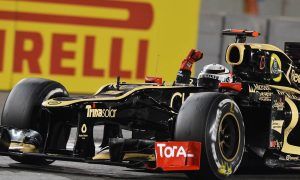
© F1i
McLAREN STYLE
At the rear, Mercedes' aerodynamicists cut the wing's endplate: five slots were made (see the yellow arrows). Although less radical than on the MCL33, the concept was obviously inspired by McLaren. Renault had already picked it up, tried it in Baku and has used it in the race since the Canadian Grand Prix. As can be seen, a certain convergence takes place, with the teams closely watching each other.
The way this part of the wing exactly works is not easy to grasp. Indeed, elongated curved winglets direct the airflow inward, and not outward (as is the case with the slats at the base of the endplate, which are part of the expansion of the diffuser effect).
One possible explanation is that the vanes channel high-pressure air to the inside of the wing, to the lower-pressure area under the main plane. This would have the effect of reducing the downforce and, especially, the drag by weakening the vortex generated at the joint area of the endplate and the wing tip.
Reducing drag is a favoured option with teams that lack straight-line speed. The curvature of the winglets could help level the pressure, which would in turn minimise the loss of downforce while still reducing drag. But that’s just a hypothesis.






